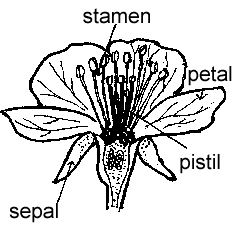BACKGROUND:
 The basic parts of flowering
plants include the roots, stems, leaves, and flowers. Stems are
important in water and food transportation, and provide support for the
leaves, flowers and fruit. Some plants store food (potatoes) or water
(cactus) in stems. Flowers are necessary for seed production, without
which many species would die out. The basic parts of flowering
plants include the roots, stems, leaves, and flowers. Stems are
important in water and food transportation, and provide support for the
leaves, flowers and fruit. Some plants store food (potatoes) or water
(cactus) in stems. Flowers are necessary for seed production, without
which many species would die out.
The main parts of a flower are
drawn on the right. A plant with colored petals and/or a pleasant scent
is usually pollinated by insects or birds. Wind or self-pollinated
plants usually have rudimentary, inconspicuous flowers. Seeds develop in
the ovary, and the ovary may develop into a fruit. Flowers that we eat
include broccoli, cauliflower and artichokes, although the last one is
actually the flower bud.
 Tree trunks are a special kind of
stem, and the age of a tree can be determined by counting the rings of a
tree trunk. A ring is actually the new water-conducting tissue that is
made each year. Thick rings mean that the tree grew a lot in the spring
and summer. Thin rings reflect bad growing
conditions, like drought, or just the fact that the tree grows slowly.
Concentric rings mean that the tree grew straight up, and rings that are
off-center, with one side wider than
the other, mean that the tree grew on a slope (look at diagram to the
left). The downhill side has wider rings. Seasonal variations in
conditions may cause color variations inside a ring. Tree trunks are a special kind of
stem, and the age of a tree can be determined by counting the rings of a
tree trunk. A ring is actually the new water-conducting tissue that is
made each year. Thick rings mean that the tree grew a lot in the spring
and summer. Thin rings reflect bad growing
conditions, like drought, or just the fact that the tree grows slowly.
Concentric rings mean that the tree grew straight up, and rings that are
off-center, with one side wider than
the other, mean that the tree grew on a slope (look at diagram to the
left). The downhill side has wider rings. Seasonal variations in
conditions may cause color variations inside a ring.
There are many different kinds of stems. They may
be underground or above-ground, woody or soft, stiff or flexible. Stems
that we eat include asparagus and potatoes. (Potatoes are very
specialized stems that help to reproduce the plant. Small semi-circular
leaf scars near the eyes show that they are stems.) Brussels sprouts are
stem buds.
PROCEDURE:
-
BEFORE CLASS: Stand a celery stalk in water for an hour or so. Then put
it in water with
 food coloring for several hours. Cut cross sections off
the end to show the veins (strings), which should be colored. In class
you may also partially strip a string from the stalk, and it should show
color. Use this as a demonstration that water moves upward through plant
tissue. Discuss that the stem of a plant is very important to move water
and nutrients up to the leaves where it will work with Sun to create
food for the plant. food coloring for several hours. Cut cross sections off
the end to show the veins (strings), which should be colored. In class
you may also partially strip a string from the stalk, and it should show
color. Use this as a demonstration that water moves upward through plant
tissue. Discuss that the stem of a plant is very important to move water
and nutrients up to the leaves where it will work with Sun to create
food for the plant.
Discuss the purpose
of stems. Show a vein that you have stripped out of the celery stalk,
and mention that this is how celery plants move water. Let them
examine the cross sections.
-
Discuss tree rings. Tell the
children that they should examine the branch cross sections with
their hand lens and answer the following questions
-
How old is the branch?
-
Did it grow on a slope?
-
Can you find rings that were produced during a
drought?
-
Have them count the number of rings on the worksheet branch and
have them color in the ring that was growing in the year they were
born.
-
Ask the students why flowers are
important to plants (i.e., they are essential to seed production.)
Mention that pollen has to land in a special place so that seeds will
develop. Point out the pollen and seed area on the large flower picture.
Instruct students to draw the flower before they dissect it. Let them
examine the flowers with a hand lens and pull them apart. Count the
petals, notice the color and shape. Have them draw a picture of their
flower on the worksheet. If possible, they should indicate where the
pollen comes from and where the seed grows. Ask them how they think the
pollen is carried on the flower they are examining.
|
 The basic parts of flowering
plants include the roots, stems, leaves, and flowers. Stems are
important in water and food transportation, and provide support for the
leaves, flowers and fruit. Some plants store food (potatoes) or water
(cactus) in stems. Flowers are necessary for seed production, without
which many species would die out.
The basic parts of flowering
plants include the roots, stems, leaves, and flowers. Stems are
important in water and food transportation, and provide support for the
leaves, flowers and fruit. Some plants store food (potatoes) or water
(cactus) in stems. Flowers are necessary for seed production, without
which many species would die out.